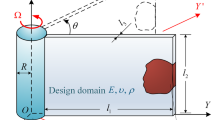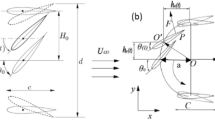Abstract
This paper investigates an optimization for the axisymmetric hub-endwall profile of a transonic fan designed for a civil high bypass ratio turbofan engine. A time-saving integrated design optimization method is proposed based on a new hub-endwall profile modification method in combination with a novel two-stage polynomial response surface. The profile modification method is proposed to change the profile of the baseline hub curve by moving three control points, so as to redesign the hub-endwall. The two-stage polynomial response surface is proposed to obtain an accurate high-order polynomial while requiring fewer sampling points, so as to reduce the computational cost. The results show that the integrated design optimization method is suitable and valuable. After optimization, the corner separation of the studied fan is weakened, and the stall margin of the core fan is also enlarged. Moreover, the aerodynamic performance of the core fan at the design speed is improved.




















Similar content being viewed by others
References
Acar E (2010) Various approaches for constructing an ensemble of metamodels using local measures. Struct Multidiscip Optim 42(6):879–896. https://doi.org/10.1007/s00158-010-0520-z
Acar E, Rais-Rohani M (2009) Ensemble of metamodels with optimized weight factors. Struct Multidiscip Optim 37(3):279–294. https://doi.org/10.1007/s00158-008-0230-y
Arnone A (1994) Viscous analysis of three-dimensional rotor flow using a multigrid method. J Turbomach 116 (3):435–445. https://doi.org/10.1115/1.2929430
Deng X, Guo F, Liu Y, Han P (2013) Aero-mechanical optimization design of a transonic fan blade. In: ASME turbo expo 2013: Turbine technical conference and exposition, pp V06BT43A014–V06BT43A014
Denton JD (1993) Loss mechanisms in turbomachines. In: ASME 1993 international gas turbine and aeroengine congress and exposition, p V002T14A001. https://doi.org/10.1115/93-GT-435
Fidalgo VJ, Hall CA, Colin Y (2012) A study of fan-distortion interaction within the nasa rotor 67 transonic stage. In: ASME turbo expo 2010: Power for land, sea, and air, pp 369–380. https://doi.org/10.1115/1.4003850
Fottner L (1990) Test cases for computation of internal flows in aero engine components
Gbadebo SA, Cumpsty NA, Hynes TP (2007) Control of three-dimensional separations in axial compressors by tailored boundary layer suction. J Turbomach 130(1):011,004–011,004–8. https://doi.org/10.1115/1.2749294
Goulos I, Stankowski T, MacManus D, Woodrow P, Sheaf C (2018) Civil turbofan engine exhaust aerodynamics: Impact of bypass nozzle after-body design. Aerosp Sci Technol 73:85–95. https://doi.org/10.1016/j.ast.2017.09.002
Grosvenor A D (2007) Rans prediction of transonic compressive rotor performance near stall. In: ASME turbo expo 2007: Power for land, sea, and air, pp 279-293. https://doi.org/10.1115/GT2007-27691
Grosvenor AD (2008) Numerical studies toward prediction, analysis and treatment of swbli in transonic compressors. In: International conference on methods of aerophysical research. ICMAR
Guo S, Duan F, Tang H, Lim SC, Yip MS (2014) Multi-objective optimization for centrifugal compressor of mini turbojet engine. Aerosp Sci Technol 39:414–425. https://doi.org/10.1016/j.ast.2014.04.014
Hecklau M, Wiederhold O, Zander V, King R, Nitsche W, Swoboda M, Huppertz A (2011) Active separation control with pulsed jets in a critically loaded compressor cascade. AIAA J 49(8):1729–1739. https://doi.org/10.2514/1.J050931
Hergt A, Meyer R, Engel K (2010) Effects of vortex generator application on the performance of a compressor cascade. J Turbomach 135(2):021,026–021,026–10. https://doi.org/10.1115/1.4006605
Ito Y, Watanabe T, Himeno T (2008) Effects of endwall contouring on flow instability of transonic compressor. Int J Gas Turb Propul Power Sys 2(1):24–29
Jang CM, Samad A, Kim KY (2006) Optimal design of swept, leaned and skewed blades in a transonic axial compressor. In: ASME turbo expo 2006: Power for land, sea, and air, pp 1279–1288. https://doi.org/10.1115/GT2006-90384
Joseph V R, Hung Y (2008) Orthogonal-maximin latin hypercube designs. STAT SINICA 18(1):171–186
Kim JH, Choi KJ, Kim KY (2013) Aerodynamic analysis and optimization of a transonic axial compressor with casing grooves to improve operating stability. Aerosp Sci Technol 29(1):81–91. https://doi.org/10.1016/j.ast.2013.01.010
Kroger G, Cornelius C, Nicke E (2009) Rotor casing contouring in high pressure stages of heavy duty gas turbine compressors with large tip clearance heights. In: ASME turbo expo 2009: Power for land, sea and air, pp 215–225. https://doi.org/10.1115/GT2009-59626
Lian Y, Liou MS (2005) Multi-objective optimization of transonic compressor blade using evolutionary algorithm. J Propul Power 21(6):979–987. https://doi.org/10.2514/1.14667
Lu H, Li Q (2016) Cantilevered stator hub leakage flow control and loss reduction using non-uniform clearances. Aerosp Sci Technol 51:1–10. https://doi.org/10.1016/j.ast.2016.01.013
Lu H, Zheng X, Li Q (2014) A combinatorial optimization design method applied to sshaped compressor transition duct design. Proceedings of the Institution of Mechanical Engineers Part G Journal of Aerospace Engineering 228(10):1749–1758. https://doi.org/10.1177/0954410014531922
Lu J, Chu W, Wu Y (2009) Effects of endwall profiling on axial flow compressor stage. In: ASME turbo expo 2009: Power for land, sea, and air, pp 145–154. https://doi.org/10.1115/GT2009-59418
Myers RH, Montgomery DC, Anderson-Cook CM (2016) Response surface methodology: process and product optimization using designed experiments. Wiley, New York. https://doi.org/10.2307/1270613
Niazi S, Stein A, Sankar L (2000) Computational analysis of stall control using bleed valve in a high-speed compressor. In: 36th AIAA/ASME/SAE/ASEE joint propulsion conference and exhibit. https://doi.org/10.2514/6.2000-3507
Ning F, Xu L (2001) Numerical investigation of transonic compressor rotor flow using an implicit 3d flow solver with one-equation spalart-allmaras turbulence model. In: ASME turbo expo 2001: Power for land, sea, and air, p V001T03A054. https://doi.org/10.1115/2001-GT-0359
Pehlivanoglu YV, Yagiz B (2012) Aerodynamic design prediction using surrogate-based modeling in genetic algorithm architecture. Aerosp Sci Technol 23(1):479–491. https://doi.org/10.1016/j.ast.2011.10.006
Reising S, Schiffer H P (2009) Non-axisymmetric end wall profiling in transonic compressors — part II: Design study of a transonic compressor rotor using non-axisymmetric end walls optimization strategies and performance. In: ASME turbo expo 2009: Power for land, sea, and air, pp 25–37. https://doi.org/10.1115/GT2009-59134
Romanelli G, Mangani L, Casartelli E, Gadda A, Favale M (2015) Implementation of explicit density-based unstructured cfd solver for turbomachinery applications on graphical processing units. In: ASME turbo expo 2015: Turbine technical conference and exposition, p V02BT39A034. https://doi.org/10.1115/GT2015-43396
Santner TJ, Williams BJ, Notz WI (2003) The design and analysis of computer experiments. Springer, New York. https://doi.org/10.1007/978-1-4757-3799-8
Spalart P, Allmaras S (1992) A one-equation turbulence model for aerodynamic flows. In: 30th Aerospace sciences meeting and exhibit.
Strazisar AJ, Wood JR, Hathaway MD, Suder KL (1989) Laser anemometer measurements in a transonic axial-flow fan rotor. Nasa Technical Report
Strazisar AJ, Bright MM, Thorp S, Culley DE, Suder KL (2004) Compressor stall control through endwall recirculation. In: Asme turbo expo power for land, sea, and air, pp 655-667. https://doi.org/10.1115/GT2004-54295
Tang X, Luo J, Liu F (2017) Aerodynamic shape optimization of a transonic fan by an adjoint-response surface method. Aerosp Sci Technol 68:26–36. https://doi.org/10.1016/j.ast.2017.05.005
Yan C, Shen X, Guo F (2018a) An improved support vector regression using least squares method. Struct Multidiscip Optim 57(6):2431–2445. https://doi.org/10.1007/s00158-017-1871-5
Yan C, Shen X, Guo F (2018b) Novel two-stage method for low-order polynomial model. Math Probl Eng 2018(1):1–13. https://doi.org/10.1155/2018/8156390
Zhang C, Hu J, Wang Z (2014) Investigations on the effects of inflow condition and tip clearance size to the performance of a compressor rotor. J Eng Gas Turbines Power 136(12):122,608–122,608–7. https://doi.org/10.1115/1.4027906
Zhang D, Tang S, Che J (2015) Concurrent subspace design optimization and analysis of hypersonic vehicles based on response surface models. Aerosp Sci Technol 42:39–49. https://doi.org/10.1016/j.ast.2015.01.003
Zhang Y, Li J, Ji L (2017) Numerical research on effects of shroud contraction on tip leakage flow and overall performance of axial compressors. In: ASME turbo expo 2017: Turbomachinery technical conference and exposition, p V02AT39A011. https://doi.org/10.1115/GT2017-63468
Zhou X, Jiang T (2016) Metamodel selection based on stepwise regression. Struct Multidiscip Optim. https://doi.org/10.1007/s00158-016-1442-1
Author information
Authors and Affiliations
Corresponding author
Ethics declarations
Conflict of interest
The authors declare that they have no conflict of interest.
Replication of results
For the convenience of other researchers, the involved codes of the proposed two-stage polynomial response surface are included in the supplementary online material.
Additional information
Responsible Editor: Hai Huang
Publisher’s note
Springer Nature remains neutral with regard to jurisdictional claims in published maps and institutional affiliations.
Electronic supplementary material
Rights and permissions
About this article
Cite this article
Yan, C., Yin, Z., Shen, X. et al. Axisymmetric hub-endwall profile optimization for a transonic fan to improve aerodynamic performance based on an integrated design optimization method. Struct Multidisc Optim 60, 1267–1282 (2019). https://doi.org/10.1007/s00158-019-02266-y
Received:
Revised:
Accepted:
Published:
Issue Date:
DOI: https://doi.org/10.1007/s00158-019-02266-y




